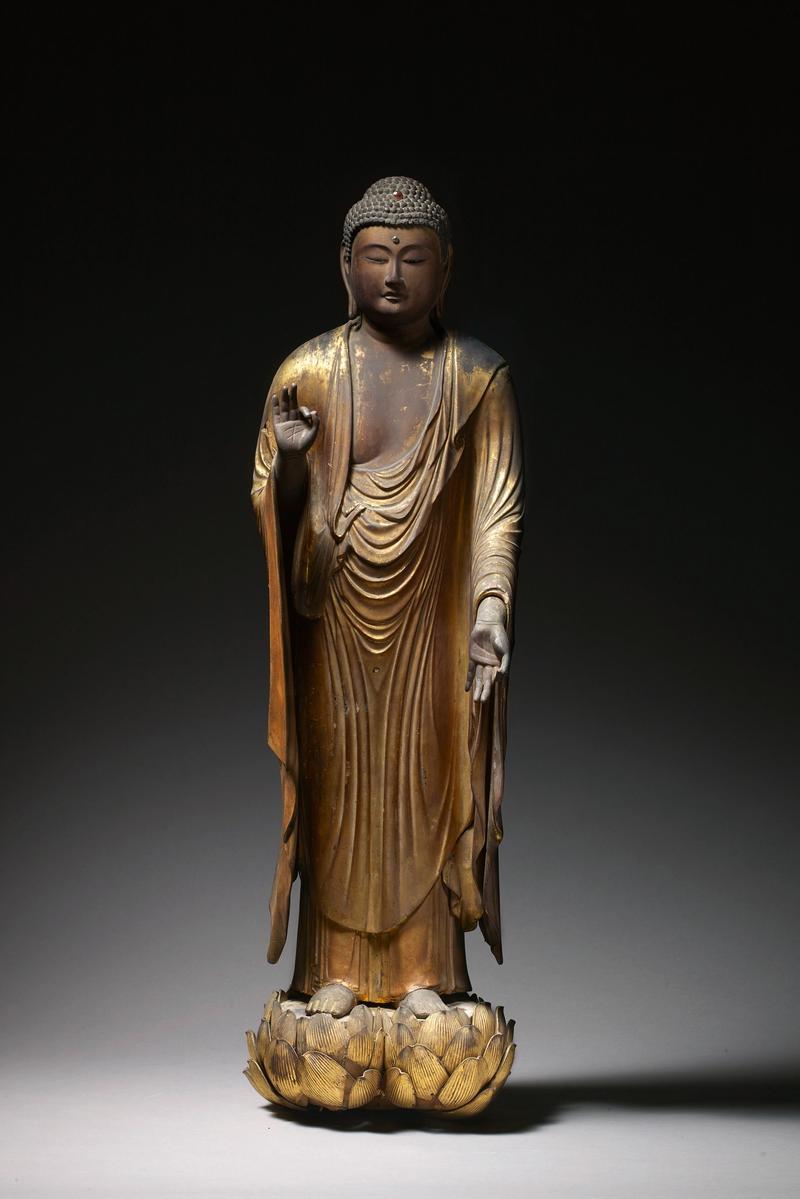A lacquered wood zushi (travelling shrine), containing a figure of Jizō Bosatsu seated in hanka-fumisage (the half-lotus position with one leg folded and the other pendant) on a rocky base before a halo with three Nyoi-hōju (wish granting jewels).
Jizō is bejewelled with a gilt-metal yōraku (pectoral ornament) with semi-precious stone beads and holds a shakujō (priest staff) in the right hand and a Nyoi-hōju in the left. The robes are decorated with floral foliage and geometric designs in kirikane (thinly cut gold patterns). The black-lacquered shrine has gilt metal mounts and the interior is gilded.
Japan, 17th century, Edo period.
Dimensions:
figure only: H. 10cm x W. 6cm x D. 4.5cm (4” x 2½” x 2”)
figure and stand: 19cm x W. 11cm x D. 8.5cm (7½” x 4½” x 3½”)
Jizō Bosatsu is one of the most beloved Japanese divinities and a bodhisattva who is believed to save all beings during the era between the death of Shaka (Gautama Buddha) and the rise of Miroku Bosatsu (Maitreya, a future Buddha). Jizō’s Sanskrit name Kshitigarbha means “the earth” and “containment” or “womb”. As such Jizō is considered to personify the “virtue of the earth”. He vowed not to achieve Buddhahood until all are saved, and thus is represented as a simple monk and embodies compassion and universal salvation. Jizō guards travellers safely on their way, protects warriors in battle, watches over the safety of children, families and women during pregnancy. As a guardian of children, he is often depicted in an endearing manner to resemble the children he protects.
The Jizō in the hanka-fumisage position such as the present figure is particularly considered to represent Enmei Jizō (Life-Prolonging Jizō) and people revered them for easy childbirth and longevity.
Jizō’s powers to save the souls reborn in the transmigration extend to all the Six Realms of Reincarnation (Rokudō): hell, hungry ghosts, animals, Asura (demigod), humans and heaven. The belief of Jizō has existed in Japan since the eighth century, becoming widely worshiped by the masses at the end of the Heian period (794-1185) when people sought salvation along with the rise of Pure Land Buddhism.
Jizo is usually shown in the guise of a priest carrying a nyoi-hōju (a jewel which grants desires) and a shakujō (priest staff). Nyoi-hōju means a jewel that has the capacity to grant fulfilment of all desires. In Buddhism, by its luminosity and brilliance, it symbolises the Buddha and the Doctrine. As a pearl, an emblem of purity, it also represents the truth of the Buddha and the veracity of the Law.
Shakujō is a Buddhist ringed staff used in prayer to make a distinctive sound and it originates from the Indian khakkhara (sounding staff). It is said that it engenders goodness by awakening the compassionate Bodhisattva heart. The shakujō is one of the thirteen things which a pilgrim monk should carry with him and its jingling sound is used to warn off small beings (e.g. vipers) from being accidentally trodden on. Ringing also helps to alert and inform villagers that there is a travelling/itinerant monk within earshot in need of alms. This staff, an attribution of Jizō is considered to have derived from his journey amongst the Six Realms of Reincarnation.
This present figure is decorated with kirikane (thinly cut gold patterns) on a plain wood, intended to evoke the appearance of sandalwood sculpture. One of the well-known Buddhist figures decorated in a similar way is a seated Yakushi Nyorai (date 1103, H. 10.7cm, National Treasure), a hibutsu (hidden Buddha or secret Buddha) of Ninnaji temple, Kyoto. For other similarly decorated examples, see: Asia Society ed., Kamakura, Realism and Spirituality in the Sculpture of Japan, (New Heaven and London, 2016), p.118-119, no. 33 (A seated Miroku Bosatsu, late 13th century, The Minneapolis Institute of Arts, 2013.30.28a,b); Tokyo National Museum ed., Tokubetsuten Kamakura-jidai no Chōkoku [Special Exhibition: Japanese Sculpture of the Kamakura Period], exhibition catalogue, (Tokyo, 1975), no. 110 (A seated Bosatsu, 13th century).
Buddhist Art

A negoro lacquer Heishi

A kakemono with the monk Hōnen

A kakebotoke

Zenkoji Kannon Bosatsu

Buddhist wood panels

A wood figure of Amida Nyorai, Heian/Kamakura period

Kakebotoke of Bishamonten

Dainichi Nyorai

A zushi with Jizō Bosatsu

Amida Buddha

Daiarakan (Sacred Arhat)

Jizō Bosatsu

Amida Buddha

A silk kakemono with Kannon

An iron nyoi

Zushi with Kannon

A bronze kakebotoke of Kannon











